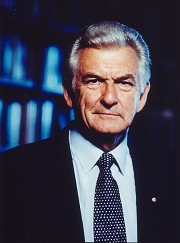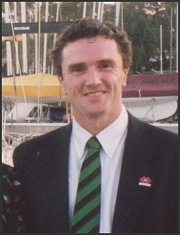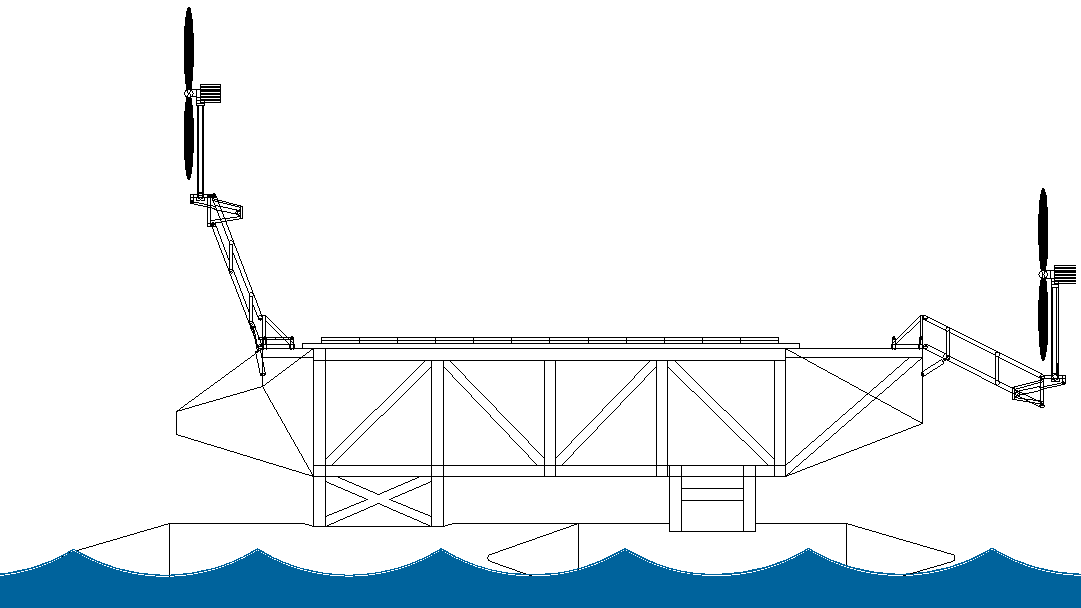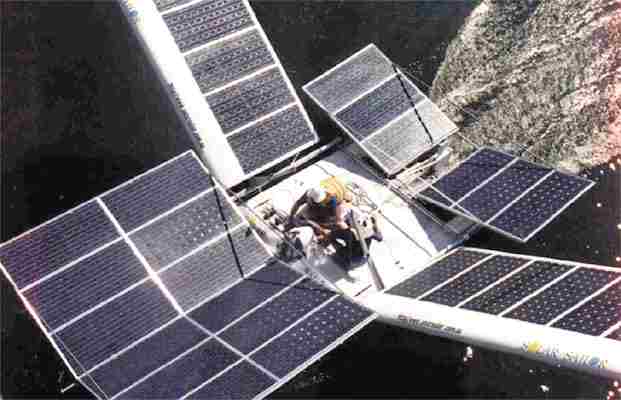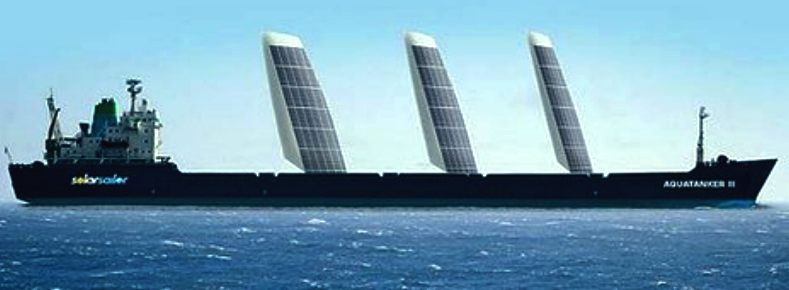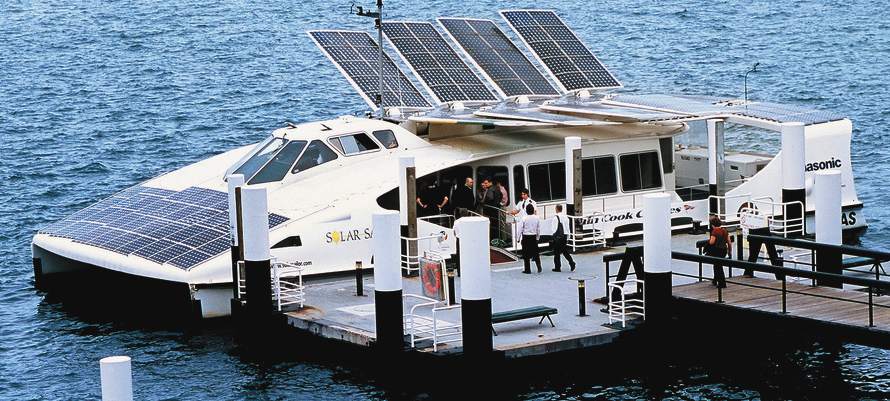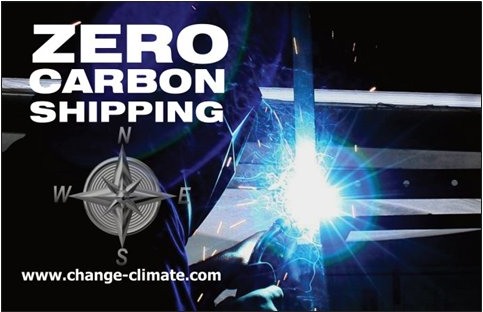|
SOLAR SAILOR
|
|||||
|
Solar Sailor was built and developed with generous support from the Australian Government, BP, Panasonic and others. It's well worth a visit to their website. An impressive machine, Solar Sailor operates as a passenger ferry in Sydney Harbour.
Nieuwsbrief@SolarSailor.nl | http://www.solarsailor.nl/en/home_text.htm
January 05, 2005
Solar Sailor -- a hybrid solar / wind boatA Newly Electric Green – Sustainable Energy, Resources and Design
Although the boat cost three million Aussie dollars to make - roughly 20% above the equivalent traditional vessel, "the company is confident that new technologies and the economics of scale will diminish this margin considerably over the next decade. However, even at current prices, depending on the degree of usage, a purchaser could expect to recoup this differential within five years through fuel savings." (And remember a five-year payback time is something like a 20% return on investment - much more profitable than the stock market, for most people.) And, of course, "In addition to reducing noise, air and water pollution from diesel exhaust, the data indicates that Solar Sailor will save 250,000 litres of diesel fuel consumed per vessel annum, an annual saving of 670 tonnes of greenhouse gas emissions per vessel."
Treehugger.com says "they also under scrutiny for duty as urban ferries, where they would use 50% less fuel". The inability to run 100% off the sun and wind when operating as a ferry is due to the application's speed requirements--the craft can only do 12-14 knots maximum estimate without also using battery/diesel hybrid assist; but cutting fuel usage in half is still a huge and admirable achievement. It's better than today's best hybrid cars do.
THE SOLAR SAILOR TEAM
Since winning the Australian Design of the Year Award in 2001, SS headed by Chairman Hon. Bob Hawke, has been successfully commercializing its hybrid electric power systems in the world market as well as selling its Flexicell solar panels. SS now has contracts with Taiwan and another under negotiation with Qingdao Shipyard in China; agents across Asia, Europe and the USA. Contracts are pending in Australia and India as well as many other "works in progress" on the world stage.
SS has recently incorporated a US subsidiary - SSUSA in Los Angeles to accelerate multiple commercial opportunities in the US. SS Pty Ltd has filed a new patent that has 3 different US grant applications pending. The Sydney Solar Sailor continues to operate successfully in a very competitive market. In 2002/3 SS signed a further 3yr plus 3yr lease with Captain Cook cruises.
The media coverage of the of the SS ferry and the technology and has been has been world-wide including Beyond 2000, National Geographic, BBC Tomorrow's World and CNN as well as press and radio. In 2002, Solar Sailor was recognized for its environmental leadership, Dr Robert Dane being made SEDA Green Ambassador of Sustainable Energy.
SOLAR POWERED FERRY - The Cross Channel Challenger (CCC) is a project currently on the drawing board looking for backing to develop a coastal cruiser that is zero carbon just like the hydrogen projects, but where the vessel converts energy from nature onboard.
This is a toe-in-the-water project for 2020-21 using budget off the shelf equipment to keep the costs down. Hence, the theoretical performance is lower than might be achieved but higher than the current benchmark. It is a useful stepping stone to medium range ferries and eventually bigger ships with longer ranges. Solar combined with wind power could be the winning combination. Comparing the two technologies will be interesting. For sure, the solar powered ferries will be safer and cheaper.
Solar and wind powered vessels do not need big hydrogen tanks next to docks for ships to fill up from. They do not need trucks to deliver the hydrogen from the conversion plants and last but not least, hydrogen is potentially dangerous, as the Zeppelin 'Hindenburg' demonstrated in 1937 when a spark ignited the fated airship, destroying it in minutes.
BBC's Tomorrow's World described SS's technology as "possibly the greatest evolution in boats since the advent of steam." Solar Sailor's intention is to take this technology to the world -green ferries for blue highways. The technology is not just applicable to environmentally sensitive waterways, all marine transport where constant high speed operations are not required, should be using this technology. When high speeds are required, a generator is used to power the electric drive direct, although fuel is being used, it is being used far more efficiently. The technology benefits both passengers and the environment -low noise, fumes, vibration, wash, air pollution, greenhouse gas emissions and no water pollution.
In designing new technology, there has to be a convincing balance between commerciality and environmental benefits when the economics of the bottom line is generally more important to operators than ecological issues. The key challenge in marketing to a traditional industry is building their awareness of the long term benefits both to the hip pocket and to the planet: lower operating costs, improved reliability and technology that exceeds all existing and proposed environmental regulations
Media Releases From Solar Sailor
October
28, 2003 Hybrid Marine Propulsion (HMP) in New York
Harbour
July
2003 Solar
Sailor new Sydney Office
July
2003 Solar
Sailor licenses "Flexicell (TM)" Technology
We can provide Flexicell (TM) standard panels for US$6.00/watt for most orders and down to $4/watt for large orders. Pictures of standard 36 cell panel and specifications are on our Solar Page of our products pages.
1st July 2003 Solar Sailor signs further 3 year contract with Captain Cook Cruises. Sydney's
premier cruise line Captain Cook Cruises today announced
the signing of a 3-year plus 3-year lease. Anthony
Haworth, Managing Director of Captain Cook Cruises
"the vessel has performed above expectations and
proven to be a popular, cost effective, reliable and
easy to operate vessel." David Franks, CFO of Solar Sailor said "the revenue from the Solar Sailor, adjusted for the additional revenue associated with the Sydney 2000 Olympics has increased in each of its three years of operations despite the present tough tourism market. We look forward to a continuing relationship with Captain Cook Cruises."
18th
November 2002 Green-lighting
greener ferries - Russell Long 2002
San Francisco Chronicle.
17th
October 2002 Solar
Sailor welcomes Mr. Bob Hawke as Chairman
17th
October 2002 Solar
Sailor recognised for Environmental Leadership 14th
October 2002 Solar Sailor attends 40th Australia-Japan
Joint Business Conference April 5, 6 & 7 - 2002 Solar Sailor took part in Solar Expo in Newcastle, NSW
04
March 2002 - Solar
Sailor venue for Dr Suzuki interview
31
Jan 2002
Solar Sailor Attends Pacific 2002
28th
November 2001 - Sydney
Solar Sailor hosts Clear Waters seminar
October
17, 2001: Dick Smith inspects Solar Panels
May 7, 2001: Solar Sailor Ferry Wins Australian Design Award of the Year - Press Release The world's first solar powered ferry has won the design industry's top honour of the Australian Design Award of the Year. The ADA press release.
February
8, 2001: Solar Sailor Opens Golden Gate - Press Release
Media Coverage on Solar Sailor
July
10, 2002: ABC's New show "Dimensions
with George Negus"
August
30th, 2001: ABC's New science show "Catalyst"
films on board the Sydney Solar Sailor
Friday 31st August 2001, Graham and crew joined us for a cruise around Sydney Harbour, during the cruise the Catalyst crew were given a demonstration on the electric motors by a member of the University of Technology Sydney. This episode of "Catalyst" will go to air Thursday the 4th of October at 8.30pm. ABC online http://www.abc.net.au/catalyst
August
31, 2001: Business and Higher Education Round Table (B-HERT's)
Distinguished Speaker Luncheon.
March
29, 2001: Business sunshine for Solar Sailor - Canberra
Times
March
2001: Here Comes the Sun - Bay Crossings
February
20, 2001: Solar Sailor Sails For Bulk Carriers - ABC
Innovations
February
14, 2001: The world's first solar and wind powered
commercial water craft - BBC Tomorrow's World
February
6, 2001: Aussies Show Off Their Solar Ferryboat - San
Francisco Chronicle
ENGINEERING
DESIGN
|
2.6. Proof of success / market potential
The current vessel has exceeded the operator’ expectations and received universal positive feedback from customers. Solar Sailor has received over fifty expressions of interest in the product for the tourism, eco-tourism and passenger transport markets.}
2.7. Do you have a patent or design registration for the product?
Yes. Solar Sailor has a patent on the “Solar Wing” in Australia, NZ, and USA, TURKEY and pending in 26 other jurisdictions.
2.8. Is the product currently being exported?
We have exported solar panels to Japan.
2.9. Does the product replace goods which are currently being imported?
No – world first.
2.10. Product life cycle and environmental considerations
The vessel has an expected life of 30 years. The solar panels, batteries and computers have no moving parts and the motors have one moving part - meaning the vessel requires little maintenance. The LPG generator has to be maintained in a conventional way. The batteries are expected to last 8 years.
The vessel has little impact on the environment. The vessel is quiet, low wash and under all modes of power creates zero water pollution. The vessel can recharge off the grid using off-peak power and when not in use can put power back into the grid at on-peak rates. Even under LPG generator power it creates no diesel fumes, or particulate matter and 50% less greenhouse gas emissions
We like this concept. It's about time the oceans were cleaned up. Such a set-up could reduce diesel costs significantly and is retro fixable, but to be able to eliminate diesel fuel altogether, something more comprehensive is needed.
2.11. Industrial Design and/or Furniture Design considerations
2.11.1. RELEVANCE OF EXTERNAL FORM AND ERGONOMIC CONSIDERATIONS
The design had to incorporate solar wings (proven on a small prototype the Marjorie K), hybrid power system and satisfy waterways requirements for safety. The wings could not go out beyond the beam of the boat and had to fit under the lowest point of navigation on its route even with the wings up. The wings had to be stowed when the wind was over 40 knots. The layout for the flow of energy had to maximise efficiency of the system and optimise the weight distribution on the vessel.
2.11.2. Aesthetics
The vessel had to functionally incorporate new technology and yet be appealing to the tourist market. The 168 square metres of solar panels were positioned above the passengers or on the bow. A 2 to one ratio of length to beam matched the 2 to one ratio of the length to width ratio of the wings. The new technology was felt best being displayed in a futuristic and aerodynamic design.
2.11.3. Safety
The vessel satisfies all NSW Waterways safety requirements. The wings are engineered to withstand 40 knots of wind with 100% margin of safety. Fire, lifesaving and visibility requirements have all been met. Conventional lead-acid gel batteries were used as they are approved in marine applications. The LPG generator was placed aft on the transom of the catamaran to reduce noise and resolve safety issues regarding heavier than air gases collecting in the hulls.
Still going strong and a fine example of technology in action.
2.11.4. Design problems encountered and solved
Wing design, Joint design, hydraulic design, computer and software design, solar panel encapsulation, motor design and the integration of this in the overall hybrid power system layout were all considered and optimised.
2.11.5. Important and innovative features
The innovative feature is the “solar wings”. The two most abundant forces on the water are the sun and the wind. The solar wing is able sail and collect solar energy. It is modeled on nature where insects evolved wings initially as solar collectors and then used them to fly. Integrated with back up electric power storage and generation, the solar wing creates a vessel that is reliable, versatile, potentially has unlimited range, can refuel at sea, is economical, pleasant to be on and has minimal impact on the environment.
2.12. Engineering Design considerations
2.12.1. describe any new concepts, innovative design features or better ways of achieving the aims of the project.
The tourist vessel was limited by conditions and regulations on Sydney Harbour. We have designs for inter island trade-wind vessels where the wings extend beyond the beam of the boat when horizontal and have a higher aspect ratio when sailing. We have concept vessels where the wing not only uses solar and wind power but also creates lift.
2.12.2. describe any simplifications achieved in the design of the product.
The layout is simple open plan, “no column” design on one level. It makes access easy and wheelchair friendly.
2.12.3. describe any additional functions incorporated in the design, more effective functionality or increased efficiency.
The vessel can be operated by a single captain and a deck hand. Closed circuit TV aides visiblity round the vessel and wing positions can be monitored by computer, on closed circuit TV or visually.
2.12.4. describe any improvements in safety.
There is no fossil-fuel below deck level in any hulls in our boat. All systems are monitored in the wheelhouse by a computer.
2.12.5. describe any improvements in the use of materials for efficient manufacture.
The hulls and superstructure were made by a yacht builder using conventional techniques.
Why not visit the: www.solarsailor.com website for more information.
Solar Sailor catamaran ferry - Sydney Harbour
Solar Sailor Holdings
SYDNEY OFFICE
Suite 206, “The Bentleigh” ,
1 Katherine Street, Chatswood NSW 2067
PO Box 640, Lane Cove, Sydney NSW 2066
PHONE NUMBERS
Telephone: +61 2 9418 6011
Fax: +61 2 9418 6939
Zero Carbon shipping without hydrogen fuel cell inefficiencies is a possibility that needs to be investigated with projects such as the solar and wind powered ferry that is the subject of applications for support.
This website is copyright © 1991- 2019 Electrick Publications. All rights reserved. The bird logo and names Solar Navigator and Blueplanet Ecostar are trademarks ™. The Blueplanet vehicle configuration is registered ®. All other trademarks hereby acknowledged and please note that this project should not be confused with the Australian: 'World Solar Challenge'™which is a superb road vehicle endurance race from Darwin to Adelaide. Max Energy Limited is an educational charity working hard to promote world peace.

